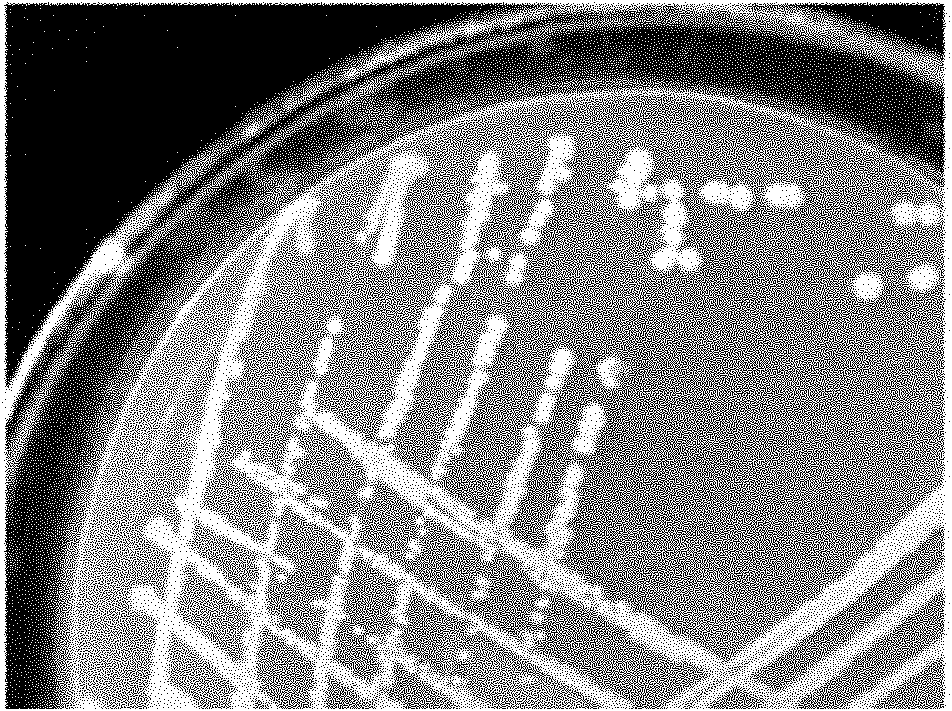High efficiency chlopyrifos degradating strain capable of generating magic spots
A technology of chlorpyrifos and strains, applied in the field of microorganisms, can solve the problems of low degradation ability, few strains, easy degradation of bacterial degradation ability, etc., and achieve the effects of in-depth research on metabolism, stable degradation performance, and strong degradation ability.
- Summary
- Abstract
- Description
- Claims
- Application Information
AI Technical Summary
Problems solved by technology
Method used
Image
Examples
Embodiment 1
[0032] Embodiment 1 bacterial strain enrichment culture method
[0033] 1) Enrichment culture: Take 1.0 g of activated sludge in the pesticide sewage treatment tank and add it to the enrichment culture containing chlorpyrifos 100mg / L. Based on 30°C, 200rpm enrichment culture for 7 days;
[0034] 2) Increase the selection pressure: transfer the above-mentioned enrichment solution to a fresh enrichment medium with an inoculum size of 10%, and double the pesticide concentration, and then continue to cultivate for 7 days, and transfer 6 times in this way until the enrichment culture The pesticide concentration in the base was increased to 800mg / L.
[0035] Wherein, the composition of the enrichment medium TYC in the step 1) is as follows: tryptone 5g / L, yeast extract 5g / L, KH 2 PO 4 1g / L and agar 15g / L, pH 7.0
Embodiment 2
[0036] Embodiment 2 Bacterial strain domestication isolation method
[0037] 1) Acclimatization culture: After the enrichment culture, 10% of the bacteria were collected by centrifugation, and then transferred to the inorganic salt medium respectively, and 600 mg / L of chlorpyrifos was added, and domesticated for two weeks under the same culture conditions; and different solvents ( Methanol, acetone, ethanol, pyridine) chlorpyrifos mother solution, to exclude the dependence of the strain on the solvent.
[0038] 2) Separation and purification: spread the acclimatized bacterial solution on an inorganic salt medium plate containing 300 mg / L chlorpyrifos by plate dilution method, and select a strain that grows well on the pesticide-containing medium, is stable in passage and has good degradation ability Carry out single bacterium colony streak separation, finally obtain the highly efficient chlorpyrifos degrading bacterial strain Klebsiella sp.CPK of purification (its preservation...
Embodiment 3
[0041] Example 3 Bacterial Strain Degradation Chlorpyrifos Detection Method
[0042] 1) TYC solid plate culture: Pick a single colony of the Klebsiella sp.CPK strain obtained in Example 2, activate it on TYC medium, and culture it at a constant temperature of 30°C until a single colony that can be picked grows.
[0043] Wherein, the enrichment medium TYC is the same as in Example 1
[0044] 2) Seed liquid culture: pick the above-mentioned activated single colony and inoculate the TYC medium (same as step 1), and culture at a constant temperature of 30°C until the logarithmic growth phase.
[0045] 3) Sampling for degradation: Inoculate the above seed solution with 20% inoculation amount into the inorganic salt MSM culture solution containing 50 mg / L chlorpyrifos as the sole carbon source, cultivate at 30°C, and take samples at different time points, three In parallel, use n-hexane equal volume vortex to extract chlorpyrifos residue, vortex for 2 minutes, and stand at 4°C for ...
PUM
 Login to View More
Login to View More Abstract
Description
Claims
Application Information
 Login to View More
Login to View More - R&D
- Intellectual Property
- Life Sciences
- Materials
- Tech Scout
- Unparalleled Data Quality
- Higher Quality Content
- 60% Fewer Hallucinations
Browse by: Latest US Patents, China's latest patents, Technical Efficacy Thesaurus, Application Domain, Technology Topic, Popular Technical Reports.
© 2025 PatSnap. All rights reserved.Legal|Privacy policy|Modern Slavery Act Transparency Statement|Sitemap|About US| Contact US: help@patsnap.com

